| | |
- "Killiks are dangerous friends, but no one's enemy."
- ―Jacen Solo
Killiks, who referred to themselves as the Kind, were a sentient insectoid species from Yoggoy in the Unknown Regions. The Killiks were once native to Alderaan in the Core Worlds. They built large mound-like structures on the plains of both Alderaan and Alsakan. Long before most other species came to these worlds, the Killiks vanished. Their disappearance from Alderaan was depicted in Ob Khaddor's moss painting Killik Twilight.
Biology and appearance[]
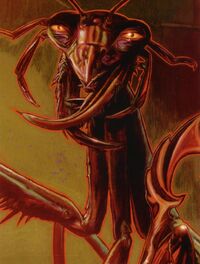
Killik insectoid head.
As a species, Killiks varied greatly in size, form and function though all shared a similar genetic code. Killiks were a genetically diverse population of intelligent insects with their society being composed of hives that were known as nests. Each nest had its members sharing the same physical characteristics. In addition, they possessed the ability to communicate with each other through a variety of means that included pheromones, electromagnetic transmissions and also long distance telepathy.[2] This pheremonal telepathic connection allowed Killiks to communicate with one another.[3] This aura-based form of communication made use of multiple methods that included heat, electrical, magnetic and probably chemical. Killik pheromones had an added impact on other species as they were able to alter the basic structure of the corpus callosum. These changes allowed Joiners to receive signal impulses directly from the brains of Killiks. The transfer agent was believed to be made through auras.[1] The Killiks were social insects and came in several different types—membrosia givers, warriors, attendants, and the deadly assassin bugs. Some hives consist of superior warriors, whereas others excel at construction, mosaic-making, subterfuge, or scouting. Some Killiks were as large as starships whilst others such as fingerlings were as small as mites.[4] Force-sensitivity was found in some types of Killiks.[3] Though the species as a whole was not Force-sensitive, certain types of Killik could be bred to use the Force in simple ways.
The species possessed a strong chitinous exoskeleton that was glossy and greenish with their carcasses capable of surviving thousands of years of erosion as seen by the colonists of Alderaan.[5] The exoskeleton also contained a number of spiracles which served as their way of breathing. This system was capable of being poisoned by the use of insecticide grenades which forcibly closed the spiracles, resulting in the Killik's death. Whilst Killiks were difficult to take alive, a special neutralizer agent was capable of allowing the creature to become docile and submissive.[4] Typically, these Human-sized hive creatures had four arms with each ending in a powerful three-fingered claw. In addition, they stood on two stout legs that appeared to be capable of leaping great distances.[5] All Killiks started as small larvae. After that, their size could vary, though a hive was usually one size.
It was noted that the majority of the Killik race were females with a few males who only left when a new nest needed to be made. Furthermore, a single Killik was able to lay a thousand eggs in a month, with those eggs turning into battle-ready nymphs within a year and by two years time, the survivors were capable of laying their own eggs. This gave them a high reproductive rate, allowing them to create millions of their kind in a short frame of time, as long as there were adequate resources. The Kind were not born, but rather when an egg was dropped a chrysalis was spun that led to a metamorphosis into adulthood.[1]
As most Killiks were female, the males were only needed for reproduction, with little else needed of them. They were only birthed in great numbers in order to help seed a new nest. A breeding female, on the other hand, had a more important role, as they laid a thousand eggs per month which in turn hatched into larvae that grew into work-ready nymphs in under a year.[2]
History[]
- "The Killiks left no other artifacts: no tools, no machines, no vehicles, no possessions."
- ―Hari Seldona
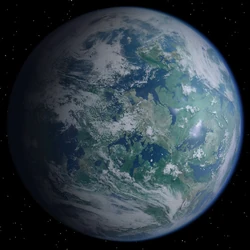
Oroboro (known later as Alderaan), homeworld of the Killiks.
Early history[]
- "The Killiks are tied to the history of the galaxy in a way we don't understand yet. They were living in cities before humans learned to build, and they were a civilization before the Sith were spawned. They were here when Centerpoint and the Maw were constructed-and they were driven from Alderaan by the beings who did it."
- ―Jacen Solo on the Killiks
The Killiks were an ancient species in the Pre-Republic era who originated from their spawnworld of Alderaan. They were known to have shared the galaxy in these early times with numerous other races such as the Celestials, Gree, Kwa, Sharu, Columi, Taung, and Humans.[6] These original insectoid inhabitants of Alderaan spread across their planet and entered neighboring star systems millennia before the foundation of the Galactic Republic.[7] Prior to 35,000 BBY, the spectacularly powerful Celestials were dominant in the galaxy and conscripted the insectoid Killiks as laborers[2] and exploited them in this role.[6] A period that was dormant in the Killiks' hive memory was of the Great Migration where their species departed their homeworld and spread into the stars whilst the rest remained on Oroboro. Killik slave-laborers were seeded up and down the Perlemian during this time.[6] The Architects, namely the Son and Daughter, were known to have directed the hives and providing them the knowledge to build wonders such as the World Puller, Still Curtain and the Chasm of Forever.[8] It was believed that they had a hand in the construction of Centerpoint Station which they called Qolaraloq and witnessed the birth of other Celestial wonders such as the Maw black-hole cluster along with the Vultar system.[2] The Thuruht hive was noted to have known the reason for the formation of the Corellian system which they referred to as the Five Rocks.[8] Killiks were believed to have held some unknown tie to the Vulagool race who hated and feared the insectoid aliens. Researchers believed that these creatures were perhaps brought to Alderaan millennia ago by the Killiks and driven to the brink of extinction when they were forced to work on the hive mounds. Others, however, claimed that the Vulagool were descendants of Killik Joiners that were mutated and later forced from the nests.[9]
According to the Killiks, an unspecified act by the Kind had led to the Celestials' anger and in response they emptied Oroboro of their number.[1] Killik slaves were also present and involved in the construction of Sinkhole Station[10] with the Thuruht hive being responsible for the imprisonment of the entity known as Abeloth.[8] By 30,000 BBY, the Celestials' influence had waned which allowed the upstart Rakata to rise into power. During this time, an incursion by Killiks engulfed the planet Korriban but was driven off by the native Sith. By this point, the Killiks vanished from the known galaxy and were relocated to the Unknown Regions which was an act presumed to be attributed to the Celestials.[6] With the absence of the Celestials, the Killiks had abandoned the civilized galaxy where they left nothing behind but their hive mounds on Alderaan along with similar such structures on nearby Alsakan.[2] A theory made by Luke Skywalker claimed that around this era the Killiks had devoured all the resources of their homeworld of Oroboro. Afterwards, they attempted to lay claim to other planets that did belong to them. As a result, the Celestials intervened and drove the Killiks into the Unknown Regions.[11] According to a Shistavanen legend, sometime during this period a Killik Sith lived in exile on the planet Sarafur after being driven off of Alsakan.
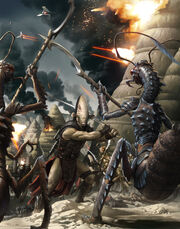
An armed conflict took place between Killiks and the Rakata.
When Human colonists discovered Alderaan in 27,500 BBY, all they discovered were the empty spires of the long vanished species that once inhabited the world.[12] By this point, the Killiks had long migrated into deep space for unknown reasons. The only evidence of their existence were the empty hive mounds.[7] The colonists arrival on Alderaan discovered a verdant world that was abandoned by this insect species.[6] All trace of this long-vanished alien race was the dirt mounds in the Castle Lands.[13] These empty constructions would ignite the imaginations of artists who created famed works of art that was inspired by the lost Killiks which included the moss painting known as Killik Twilight.[2] It was discovered that each successive generation of Killiks showed degrading levels of technological sophistication. Thus, it seemed that the Alderaanian Killiks had lost their ability to function together as a hive organism with their society descending into chaos. The Alderaanian colonists in turn came to a world that was littered with the debris of the Killik civilization.[5] The pre-Alderaanian colonization history of the planet remained lost except within the hive mind of the insectoid Killiks.[14] Meanwhile, The Colony that had departed into deep space sought out a new homeworld for themselves but were unable to find a suitable planet. This led to the lost kin separating into a thousand nests that went their different paths.[4] These departed Killik nests retreated into the Unknown Regions where they remained on a handful of isolated planets for thirty millennia.[2]
The Old Republic[]
- "Legend has it Killiks once ruled the planet. Supposedly, most flew to the stars -- but how many remained in hibernation?"
- ―Rylan Stallos
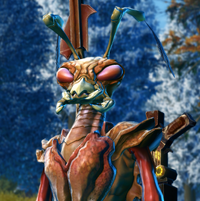
The Killik hives reemerged during the Cold War
In truth, a few Killiks had remained behind on Alderaan where they lived in hibernation deep underground. Every few hundred years, these Killiks emerged and came into conflict with the colonists before retreating whereupon they entered into their slumber once more. Alderaanians viewed the Killiks as monsters out of legend though none knew how the Killiks viewed the Human inhabitants of Alderaan.[7] Amongst the most legendary hive known to the Alderaanians was the Black Hive. These hibernating groups of nests located underground beneath the Castle Lands were completely unaware of the fate of the lost nests that departed their homeworld with even the reason for their departure being forgotten. All that was known was that a primal memory of the exodus was present within the hive mind. These hibernating Killiks only emerged to the surface every few hundred years and came into conflict with the Alderaanian colonists that now occupied the planet. The people of Alderaan also established the Order of Extermination at some point that was tasked with eliminating the Killik threat whenever it emerged.[4]
The Oroboro nests once again awoke during the Cold War era where they were engaging the Alderaanians during the conflict that emerged over the planet's throne between the noble houses. In this time, House Ulgo also learnt a means of controlling Killiks to serve their military forces which was achieved through a site known to the hive as the Pain Factory where they tortured Killiks in order to lead them to swarm against the House's enemies. Science Commander Keikana Herot tasked an agent with destroying the pain factory and desired to use the data to control the Killiks for the Republic's cause. Doctor Parren intended to study a live Killik specimen as part of her attempts at learning to domesticate the insectoid species. The Imperial Science Bureau's Project Protean were interested in the Killiks and had Vector Hyllus of the Imperial Diplomatic Service purposely transformed into a Joiner to study the effects of the process. Attempts were also made at using specialist weapons against the emerging Killiks such as the Mother's Milk poison and Blood Boiler. In addition, the Science Bureau developed a device known as the Brood Totem that worked to attract Killiks and it was planned to use the machine to lure swarms to attack their enemies.[4]
In the Cold War, the Dawn Herald Vector Hyllus accompanied Imperial Intelligence agent Cipher Nine and intended to seek out the lost kin that had left on the Great Migration centuries ago. Ambassador Hyllus also sought to promote an alliance between the Sith Empire and the Killiks.[4] In the eras that followed the end of the Second Great Galactic War, the alien insectoids were considered long extinct with one of the few traces of their civilization being their ruins with many mysteries surrounding them.[5]
Dark Nest Crisis[]
Coming of the Joiner King[]
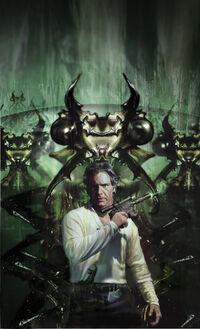
The Colony rediscovered.
The Killiks would remain sequestered in the Unknown Regions for millennia.[2] In 0 BBY their home world of Alderaan was destroyed by the Death Star, but no Killik was present on Alderaan when it was destroyed. The insectile species had long existed within their own private pocket in the Unknown Regions.[12] Their expansionist impulses were kept in check and they only spread to a handful of worlds in the Unknown Regions. This period saw occasional acts of extermination between rival hives in warfare.[2] The reconnaissance corps of the Chiss Expansionary Defense Fleet had been aware of the existence of the Killik Colony for centuries. Whilst observing them, they noticed the insectoids were slowly expanding over time but were never classified as being a threat. At this time, the Chiss had suffered labor shortages as a result of the Third Vagaari War that led to several of the families hiring entire nests from the Colony. This was deemed a perfect solution as the insectoid aliens were plentiful, industrious and not averse to risk. The Chiss were aware of the potential creation of Joiners from contact with Killiks and thus imposed very stringent precautions. However, for reasons not truly understood, these precautions broke down due to the result of sabotage. It was suspected that this was the result of possible Chiss interfamily rivalries that resulted in two entire families becoming Joiners. Whilst devastating to the Chiss, a further three families had become critically dependent on insect labor that led to a dispute within the Chiss Ascendancy.[1]
A significant change occurred amongst the Killiks in 27 ABY, a starship called the Tachyon Flier—carrying three Force-sensitive Humans including Raynar Thul—crashed on Yoggoy, one of their colonies. Raynar Thul dragged Lomi Plo and Welk, the two remaining survivors and Dark Jedi, from the burning wreck, though they were all badly burned and mutilated. The Killiks there rescued them and began to heal the survivors. Eventually, all three were absorbed into the Killik hive mind.[1] Whilst undisturbed by the Yuuzhan Vong War, the Killik Colony was stirred into a state of frenzy following the accidental arrival of these castaways.[12] The absorption of these Force-sensitive Joiners led to the primary rise of Killik Force abilities.[3] Raynar Thul took on the persona UnuThul while Lomi and Welk became the leaders of the Dark Nest or Gorog, a secretive Killik hive. Since Raynar had been absorbed into the Killik hive mind, his values became their values, especially his value of individual life. When Raynar emerged, he was in control of the Yoggoy nest, and began changing it to better help the Killiks. In time, the Yoggoy hive spread about local space, to provide for itself and share the "gift" of Raynar among the Kind. Thul's efforts included the use of trade for food and equipment between the nests along with the establishment of the Unu nest. This era was not without conflict as there were attacks from a disapproving nest along with a period of starvation as the flourishing nests stripped their worlds bare but the beginning of the Colony was cemented as the Kind spread across local space.[1]
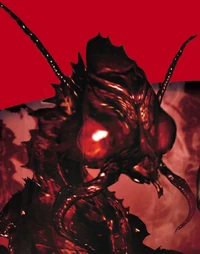
A Killik during the Swarm War
The result of this encounter led to the imposition of a single Will on the Colony that led to nests all across sectors acting in concert with one another where they pursued a single unified purpose, namely expansion. In 29 ABY, the first satellite nests began to appear on the border of the Chiss Ascendancy. In addition, an exponential population growth erupted amongst the Killiks after they began to make use of hospitals to care for their sick and began to use interstellar trade to alleviate the cyclic food shortages that had once kept their population numbers in check.[1] The process was not an easy one. While Killiks were peaceful, like most hive based species, they had no value on individual life. At least one rival nest attacked the Yoggoy hive, but the hive survived, either defeating or absorbing the attacking nest. Then, the cyclical food shortages, which had never faced the Killiks before, required them to begin trading with other planets and races. However, they also began absorbing more non-Killiks into their hive mind. By 35 ABY, when the Killiks were rediscovered by the Galactic Alliance, they were still barely surviving. At the same time, the Colony had expanded to 375 nests, though it is unknown how much of the total population of Killiks this represents. However, the existence of the Dark Nest was unknown to most Killiks.
In 35 ABY, under the manipulation of the Dark Nest, the Killiks began expanding into the borders of the Chiss Ascendancy, starting a dispute which the Galactic Alliance was forced to mediate. Following their absorption into the Killiks, the Joiners introduced the insectoid species to the Galactic Alliance in 35 ABY.[3] In an attempt at bringing a peace, it was deemed that Qoribu was too close to Chiss territory. As a result, it was expected that the nests were going to make more contacts with Chiss exploration and mining crews that would provoke renewed hostilities. The Jedi delegation managed to trick Raynar Thul into believing that the nests were growing hostile as a result of accepting Chiss Joiners and that the only way to avoid this was by moving the nests from that region of space. Leia Organa Solo offered a newly discovered region of space containing rich paradise world in the Utegetu Nebula. Such planets offered plenty of lush foraging ground for the Killiks who were always interested in expanding into new territory. Furthermore, they were located in a subsector on the edge of Colonyace. Whilst an attractive prospect, the Killiks lacked the means of relocating the entire Taat nest though the Jedi offered the use of the Hapan Battle Dragons as transports. Once the terms of the Qoribu Truce were accepted, the Killiks departed for the Utegetu Nebula as part of the tense peace agreement.[1] The temporary cease-fire saw the Killiks move to the cluster of uninhabited planets in the Paradise Nebula.[12]
Swarm War[]
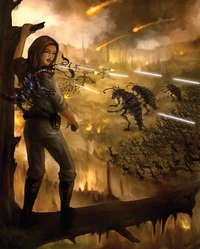
The Swarm War between the Killiks and the Chiss
Under the terms of the Qoribu Truce, the Killiks of the Colony agreed to settle Woteba and 13 other planets in the Utegetu Nebula rather than continuing expansion into Chiss space. Woteba was settled by the artistic Saras hive. Unfortunately for the Killiks, Woteba and all of the other planets in the nebula had an ancient environmental defense system. Whenever the planet was hit by the nova that formed the Utegetu Nebula, all animal life was wiped out, but plant life was restored within two years by the defense system. At first, Woteba seemed a paradise for Killik colonization, but the planet attacked them anytime they interfered with the ecosystem, destroying both structures and living beings with a corrosive substance known as Fizz, nano-machines which broke down the intrusive objects or beings on the molecular level. As a result, the Killiks believed the Jedi had purposefully sent them to the planet to fall victim to the Fizz, but this was not true, merely a lie of the Dark Nest. At the same time, the Dark Nest had been sponsoring the use of pirates that were being used against the Galactic Alliance and smuggling black membrosia that had an addictive effect on the galaxy's insectoid races.[16]
In 36 ABY, the Killiks abandoned the Nebula for fourteen nest ships built in the Tusken's Eye, alongside the nest ship of the Dark Nest. This fleet captured the Galactic Alliance Victory-class Star Destroyer Admiral Ackbar in preparation for their invasion of the Chiss Ascendancy, thus starting the Swarm War. The hijacking of the Star Destroyer led to increased tensions with the incident putting the Galactic Alliance and the Killiks into a state of war.[12] Attempts to prevent war were ruined when Jedi Knight Jacen Solo attacked a ship of the Chiss Expansionary Defense Force in an attempt to lure them into a preemptive strike against the Killik. Many of the Killik allies were insectoid races including Fefzes, Flakaxes, Geonosians, Yam'rii, Snutibs, S'krrrs, Verpines, and Vratixes due to the fact that they became Joiners more quickly. During the war, the forces of the Galactic Alliance were led by Supreme Commander Gilad Pellaeon, and the New Jedi Order by Grand Master Luke Skywalker. The Alliance eventually won, despite that a Killik coup of Thyferra resulted in the loss of Bacta. After their defeat the Killks went back to their original culture in peace and isolation from the rest of the Galaxy including the Chiss in the Unknown Regions.
With the conclusion of the Swarm War, teams of Jedi from the Jedi Order began seeding more than half of the Killik Colony's planets with the Fizz nanotech agent that had been discovered in the Utegetu Nebula. It was believed that this would rise to a hundred percent based on the Jedi's knowledge of Killik territory. This was believed to be a failsafe that would prevent the Killiks from reconstituting the Colony as if they began overpopulating their own worlds than the nanotech environmental defense agents would bring down the nests to a more manageable level. Whilst the Chiss were unsatisfied, it was believed that the Killiks had no further reason for restarting hostilities and would soon lose the capacity to do so.[11] By this point, it was believed that the Killiks began to revert to their natural state.[3]
Apocalypse[]
Afterwards, in 44 ABY, Jedi Knights Raynar Thul, Lowbacca and Tekli journeyed to the Celestial Palace in the Reo system in order to speak with the Thuruht Queen about the recently freed Abeloth. In response to this news, the Queen had her entire nest prepare for the end of the galaxy.[8]
Society[]
- "Bugs! Why did it have to be bugs?"
- ―Han Solo
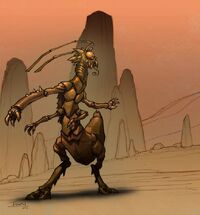
A Killik
The Killiks had a communal society, with each and every Killik being in mental contact with another. Due to their hive mind, every Killik nest was virtually one individual. Each hive appeared to have a palindromic name; even the word "killik" shared this feature. The Killiks were also peaceful in nature. Their telepathic connection was capable of extending to other species which included non-insectoids who became Joiners. These individuals lost their independent will once they became absorbed into the hive-mind.[3] Through the use of Killik pheromones, these individuals were completely subsumed into the Will. Only individuals from the same nest shared a truly collective mind. Whatever the collective mind knew, the entirety of the Killiks knew. This was described as being a sort of highly advanced telepathy where an individuals accessed the thoughts and sensed the impressions of the entire nest. Insects from different nests, however, needed to communicate to one another through language as the collective mind did not extend far beyond the confines of the nest. In order to participate in the collective mind, an individual needed to always be within the range of another Killik's aura who in turn needed to be in the approximate radius of another in turn. This was entirely expected from a communication medium that worked by way of auras. As a result, the collective mind was able to extend over quite a large area so long as there existed an unbroken chain of Killiks. During the Dark Nest crisis, it was not entirely known how the central Will exerted its control over the entire Colony as the distances involved were too great for it to function through auras as the collective mind functioned. Such a central Will had to be magnitudes stronger than those of the individual nests in order to control them. Gifted Joiners were even able to draw upon the Force potential of an entire nest, as Raynar had grown more powerful in the Force.[1]
This meant that all members of the Kind had a tendency in confusing belief with reality. Their hive mind meant that their memory could come from any number of sources. This ranged from a Killik's own experience or the experiences of a Joiner or even events enjoyed by an individual prior to becoming a Joiner. Such experiences had no difference to one another to the hive mind with all being counted as a single one. In time, a hive's collective memory became a random mesh of recollections where fact, fiction and myth were all intermingled with one another to the point that a single truth recounted by the Killiks was considered not entirely reliable. This meant that their stories such as those concerning the Ones could not entirely be from the Killiks own experiences but rather some other species creation myth. As a result, they were noted for holding a highly muddled sense of history.[8]
Similar to many insectoid species, Killiks desired to increase their numbers through their high birth rates and expand their territory. This stemmed from an instinctual response to combat the threat of extinction with even other Killik hives being viewed as competition and obstacles towards success. Thus, many wars had been fought between non-linked Killik hives with hundreds of thousands being exterminated in the millennia since being relocated to the Unknown Regions. The various nests were driven by specializations with this unique nature ensuring that the nests survived diverse climates and geographies. Furthermore, it ensured that members to assist their species by pledging their gifts to the service of the greater good of the Colony. When a specific need was discovered by the communal will, Killiks were capable of creating entirely new breeds in only a few generations.[2] Killiks were also noted to rarely cooperate with liars.[8]
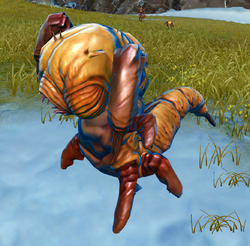
A Killik larva.
Their society was centered around a hive mind that made Killik groups act as an individual.[3] Society amongst the Killiks consisted of a collection of hive minds with different personalities. Some were violently territorial whilst others were gentle and reclusive. Individual Killiks held no sense of identity or self with each capable of unquestionably sacrificing itself for the benefit of the nest.[7] The thought processes of Killiks was stated to be different from other species. Prior to the arrival of UnuThul, they were known to take dying beings into their care where they waited to hear the Last Note before sharing the deceased's flesh with their larvae.[1] As a result, Killiks were unable to comprehend the value that other races placed on individuals. This in turn led to a difficulty in them interacting or even negotating with other species. However, they did hold values of their own and were capable of creating beautiful works of art whilst engaging in complex ritual behavior.[7] Killiks were also noted for making use of mosaics that were used to show events in their history.[1] The more noted strength of the Killik hive mind was its capacity to absorb individuals from other races into its own. This was accomplished by way of altering the brain chemistry of these individuals in order for them to correspond to the will of the nest which in turn transformed them into Joiners.[7]
In war time, the Colony used the individual hives to combine their efforts and talents in order to turn the Killiks into a veritable death-bringing machine. Specialist nests such as the Kolosolok and Rekker were capable of serving as heavy hitters on the battlefield whilst air assault was provided by the Aebea along with the Qeeq. The Gorog, Mollom and Jooj provided more specialist roles as warriors in the field whist the likes of the Wuluw along with the Taat provided non-combat support.[2] Typically, whilst clearly intelligent, the Killiks customarily showed little concern for life. When a member was injured, its companions simply abandoned it and when food was scarce than entire columns simply wandered off to die.[1] Archaeological speculation on Alderaan held the view that the Killiks built their earthen cities in certain areas until either their food ran out or their population grew too large. At such points, it was believed that they abandoned their homes and swarmed the great plains until they found the site for a new home whereupon they built a new city to house their population with this process being repeated in an a near endless cycle.[5] More modern Killik hives were stated to no longer be organized around a queen though older ones were said to retain this structure to reflect their great age.[8]
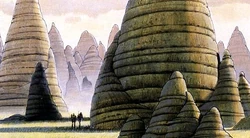
The petrified mounds of the Killiks in the Castle Lands.
It was believed that the desire to recruit new members by way of Joiners was also traced to the same need to expand.[2] Visitors would become Joiners following exposure to Killik pheromones over an extended period of time. Though the hives rarely engaged in deliberate recruitment unless there was something important a new Joiner could provide to the Killiks.[8] Amongst the Killiks, it was not unusual to see aliens carrying out work for their hives and their species believed that the galaxy would be better if the random or contradictory efforts of egocentric races was instead harnessed under universal cooperation.[2] The Killiks were known to not understand droids as they were alien to them due to the fact that they could never become Joiners which was why they were not welcomed by the Kind. This line of thought meant that the Killiks did not like artificial body parts as they believed such devices blurred the line between living beings and droids.[8]
Killik industry was noted for its unlimited potential. The Thuruht hive recounted that once they had used the Force as part of these construction efforts in distant times that had been given to them by the Architects. In these times, they used it to not only assemble space stations but move themselves through space without the aid of technological devices. Similar feats included the use of Force blasts to extract ore from a stony asteroid or using telekinesis to move ore into a smelting furnace that was powered by another swarm that used a ball form of Force lightning. They claimed that when they built they had used the Force for all things.[8] To those species that knew them, the Killiks were known to be producers of the popular alcoholic beverage known as Membrosia. However, they were also known for the constructions they sometimes left behind on the worlds they occupied. These included large round edged hive mounds which were the size of multistory buildings and were able to survive both wind as well as erosion.[2] Their hives tended to hold vast chambers that contained hundreds of pits which, in a healthy hive, would contain incubation cells.[8]
The species were known to believe that war was a part of the galaxy's cycle of change. They held the view that when war grew too powerful than the entity known as Abeloth arrived in order to destroy the old order and bring about the rise of a new one. They also held a great deal of reverance towards those they deemed as the Architects namely the group of Force wielders called the Ones. This was to the point that they felt that they were members of the Kind. It was the Architects that joined the Killik hives that allowed them to build the numerous wonders during ancient times. The Thuruht believed that once the pact was made and they emerged from hiding that their hive had to be ready to answer their call.[8]
These insectoids possessed their own language that was incredibly subtle and complex. Touch and stress had dependent meanings and there were over thirty different vowels that all sounded like the letter "U" to the human ear. Body language ranged from the clacking of mandibles being seen as a shrug whilst the curling of antennae was the equivalent of a nod. One ritual conducted by certain hives was the grooming of a Killik such as a queen that was considered an honor and its purpose was the removal of external parasites.[8]
Known Killik hives[]
Castle Lands on Alderaan[]
Unknown Regions[]
- Aebea
- Alaala
- Gorog (Dark Nest)
- Horoh
- Iesei
- Jooj
- Kolosolok
- Lizil
- Mollom
- Mueum
- Qeeq
- Rekker
- Saras
- Sotatos
- Taat
- Thuruht
- Togot
- Unu
- Wuluw
- Yoggoy (capital)
Behind the scenes[]
The Killiks were first mentioned in The Illustrated Star Wars Universe, which contained artwork of Alderaan grasslands with Killik mounds. The art was created by Ralph McQuarrie, who developed the grasslands to show Sicemon, a planet originally set to appear in Star Wars: Episode VI Return of the Jedi. This same artwork was later used in Star Wars: The Clone Wars, an animated television program, to create the planet Maridun, translating the Killik mounds into Lurmen seedpods.[17]
In Dark Nest I: The Joiner King, C-3PO cites the Killiks as being a coleoptera and hymenoptera hybrid.
Every name of the various Killik nests is a palindrome, apart from the Castle Lands (Castle Lands were also known as Oroboro, a palindrome) as is the word Killik itself.
The Chiss diplomat Formbi noted that the Killiks were one of the Terrors of the Unknown Regions that the Chiss along with the Empire of the Hand fought to contain.
Appearances[]
Sources[]
Notes and references[]
- ↑ 1.00 1.01 1.02 1.03 1.04 1.05 1.06 1.07 1.08 1.09 1.10 1.11 1.12 1.13 1.14 1.15 1.16 Dark Nest I: The Joiner King
- ↑ 2.00 2.01 2.02 2.03 2.04 2.05 2.06 2.07 2.08 2.09 2.10 2.11 2.12 2.13 The Unknown Regions
- ↑ 3.0 3.1 3.2 3.3 3.4 3.5 3.6 Jedi vs. Sith: The Essential Guide to the Force
- ↑ 4.0 4.1 4.2 4.3 4.4 4.5
 Star Wars: The Old Republic — Alderaan Environment
Star Wars: The Old Republic — Alderaan Environment
- ↑ 5.0 5.1 5.2 5.3 5.4 5.5 The Illustrated Star Wars Universe
- ↑ 6.0 6.1 6.2 6.3 6.4 The Essential Atlas
- ↑ 7.0 7.1 7.2 7.3 7.4 7.5
 Star Wars: The Old Republic — Codex: "Killik"
Star Wars: The Old Republic — Codex: "Killik"
- ↑ 8.00 8.01 8.02 8.03 8.04 8.05 8.06 8.07 8.08 8.09 8.10 8.11 8.12 Fate of the Jedi: Apocalypse
- ↑
 Star Wars: The Old Republic — Codex: "Vulagool"
Star Wars: The Old Republic — Codex: "Vulagool"
- ↑ Fate of the Jedi: Abyss
- ↑ 11.0 11.1 Dark Nest III: The Swarm War
- ↑ 12.0 12.1 12.2 12.3 12.4 The New Essential Chronology
- ↑ The Essential Guide to Planets and Moons
- ↑
 Star Wars: The Old Republic — Codex: "History of Alderaan"
Star Wars: The Old Republic — Codex: "History of Alderaan"
- ↑ Star Wars: The Old Republic
- ↑ Dark Nest II: The Unseen Queen
- ↑
 "Jedi Crash" Trivia Gallery on StarWars.com (backup link); image #7 (of 7)
"Jedi Crash" Trivia Gallery on StarWars.com (backup link); image #7 (of 7)
